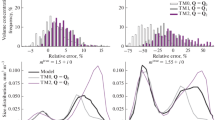An important problem of remote monitoring of scattering particles in the lower atmosphere is the development of methods for obtaining information about the microstructure of the scattering layer based on the measured backscattered signal. The main parameters of the microstructure of the surface layer of the atmosphere (particle concentration and cross-sectional area) and main measured quantities during LiDAR sounding (backscattering and extinction coefficients) were considered. During a single-frequency LiDAR sounding, these coefficients can be associated with an equivalent scattering medium consisting of monodisperse particles. This makes it possible to interpret the backscattering and extinction coefficients based on the microstructure of an equivalent medium. The quantity directly related to the transverse particle size is the angular size of the halo around the beam propagating in the scattering medium. An example of a two-position sounding scheme was used to consider the methods for measuring the angular size of the halo around a beam that has passed through a scattering screen. The scattering screen represents an opaque plane with apertures, the projections of which are the images of the particles. It is shown that doubling of the angular size of the beam passing through the screen results in the optimized angular size measurement scheme. This can be achieved either by choosing a linear magnification, according to which the images of the particles on the screen are created, or by moving the screen along the sounding line. The implementation of these methods makes it possible to describe the polydisperse and nonspherical particles contained in the surface layer of the atmosphere by using the cross section of the equivalent particles. Thus, it becomes possible to use the remote methods to monitor the surface layer of the atmosphere.



Similar content being viewed by others
References
K. Paramesvaran, K. O. Rose, and B. V. Krishna Murthy, Appl. Opt., 30, No. 21, 3059–3071 (1991), https://doi.org/10.1364/AO.30.003059.
V. V. Veretennikov, V. S. Kozlov, I. E. Naats, and V. Ya. Fadeev, Opt. Lett., 4, No. 12, 411–413 (1979), https://doi.org/10.1364/OL.4.000411.
E. Chemyakin, S. Burton, A. Kolgotin, D. Müller, C. Hostetler, and R. Ferrare, Appl. Opt., 55, No. 9, 2188–2202 (2016), https://doi.org/10.1364/AO.55.002188.
I. Veselovskii, A. Kolgotin, V. Griaznov, D. Muller, U. Wandinger, and D. N. Whiteman, Appl. Opt., 41, No. 18, 3685–3699 (2002), https://doi.org/10.1364/AO.41.003685.
J. A. Hoffnagle and C. M. Jefferson, Appl. Opt., 39, No. 30, 5488–5499 (2000), https://doi.org/10.1364/AO.39.005488.
M. I. Mishchenko, J. Quant. Spectrosc. Radiat. Transf., 110, No. 11, 808–832 (2009), https://doi.org/10.1016/j.jqsrt.2008.12.005.
G. P. Arumov and A. V. Buharin, Current Problems in Remote Sensing of the Earth from Space, 18, No. 3, 298–306 (2021), https://doi.org/10.21046/2070-7401-2021-18-3-298-306.
M. Born and E. Wolf, Principles of Optics, 4th edn., Pergamon Press, Oxford and New York (1970).
G. P.Arumov, A. V. Buharin, and A. V. Tjurin, Proc. Int. Conf. MSS-14 “Mode Conversion, Coherent Structures and Turbulence,” 24–27 November 2014, Moscow, LENAND Publ. (2014), pp. 18–23.
G. P. Arumov and A. V. Buharin, Proc. 15th Int. Sci. Tech. Conf. “Opticheskie metody issledovanija potokov,” 24–28 June, Moscow, Pero Publ. (2019), pp. 23–31.
M.J. Kavaya and R.T. Menzies, Appl. Opt., 24, No. 21, 3444–3453 (1985), https://doi.org/10.1364/AO.24.003444.
Acknowledgment
The work was carried out within the framework of the program of the Russian Academy of Sciences and the Ministry of Science and Higher Education, subject “Monitoring,” state registration No. 122042500031-8.
Author information
Authors and Affiliations
Corresponding author
Additional information
Translated from Izmeritel’naya Tekhnika, No. 10, pp. 31–36, October, 2022.
Rights and permissions
Springer Nature or its licensor (e.g. a society or other partner) holds exclusive rights to this article under a publishing agreement with the author(s) or other rightsholder(s); author self-archiving of the accepted manuscript version of this article is solely governed by the terms of such publishing agreement and applicable law.
About this article
Cite this article
Arumov, G.P., Bukharin, A.V. Selection of the Optimal Paths for Remote Measurements of the Microstructure of a Scattering Object. Meas Tech 65, 734–741 (2023). https://doi.org/10.1007/s11018-023-02146-4
Received:
Accepted:
Published:
Issue Date:
DOI: https://doi.org/10.1007/s11018-023-02146-4



